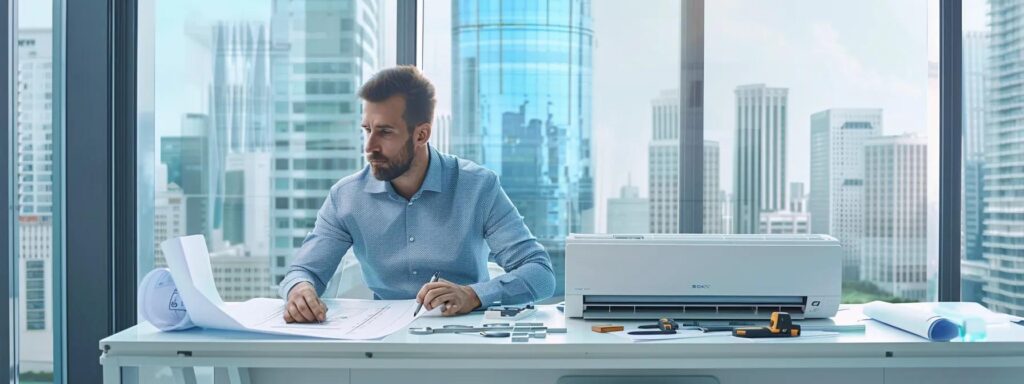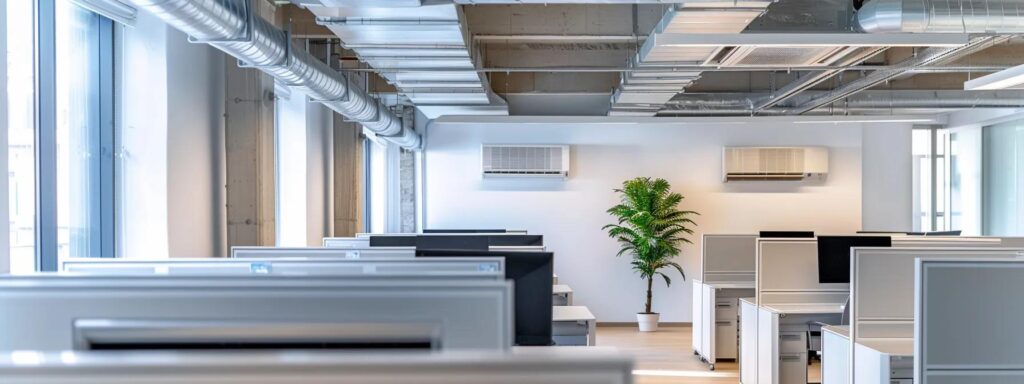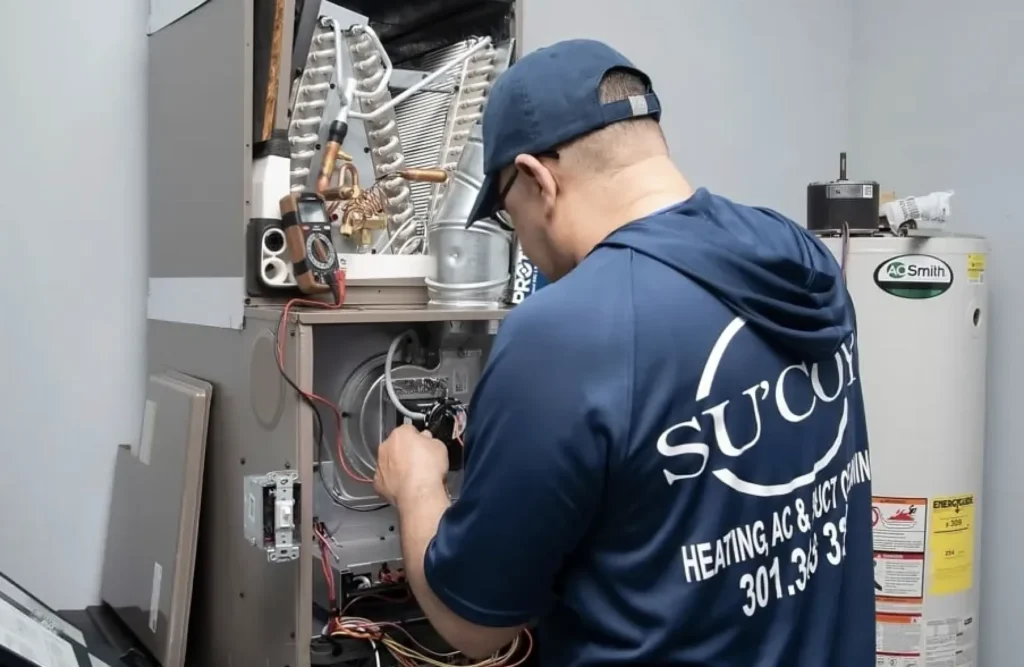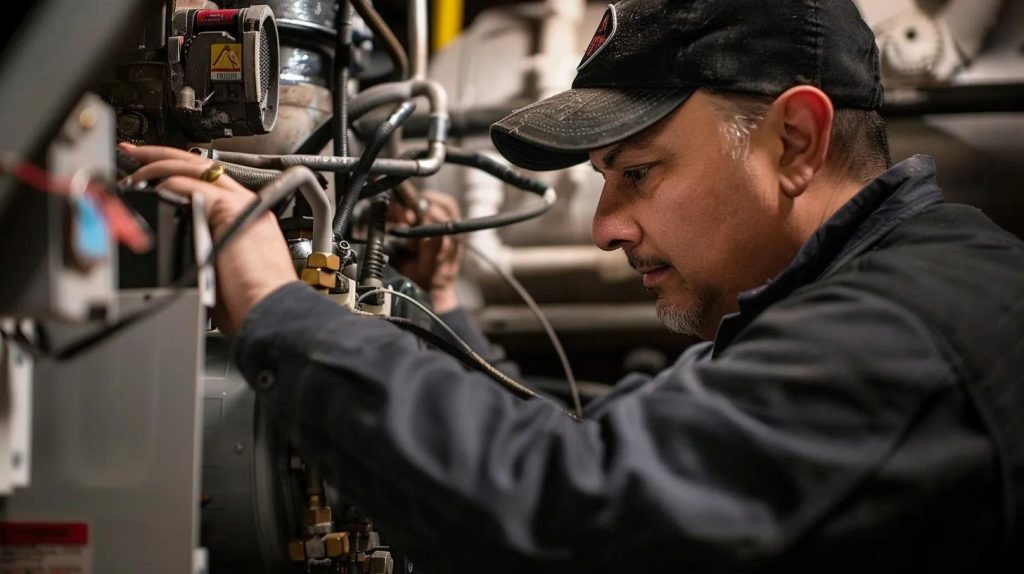What Are the Benefits of Commercial AC Installation in Northern Virginia?
The commercial HVAC industry in Northern Virginia is evolving rapidly as businesses demand more reliable, energy-efficient, and high-performing air conditioning systems.
With rising energy costs and increasing environmental concerns, companies are investing in high-quality HVAC equipment and maintenance services to not only stay compliant with local regulations but also to reduce their carbon footprint and boost productivity.
Su’Coy HVAC, with over 28 years of experience, provides top-tier commercial HVAC services that include installation, repair, and maintenance of various systems.
This article explains the entire process of commercial AC installation and maintenance, outlines the benefits and specifics of systems used in Northern Virginia, and describes best practices when selecting a commercial HVAC contractor.
By understanding the commercial AC installation needs, system design, regulatory considerations, and maintenance plans in this region, customers can achieve optimal indoor air quality, energy efficiency, and long-term savings.
The discussion below will present detailed insights into planning, executing, and maintaining commercial HVAC systems.
Understanding Your Commercial AC Installation Needs in Northern Virginia

Commercial AC installation in Northern Virginia requires a comprehensive planning strategy that takes into account the specific cooling requirements of each building.
The diverse climate in Northern Virginia – marked by humid summers and relatively mild winters – means that businesses need an HVAC system designed to handle significant temperature variations and high humidity to maintain indoor comfort.
Assessing your building’s specific cooling requirements involves analyzing factors like the square footage, insulation levels, number of occupants, and the type of commercial activities conducted.
This process helps in estimating the cooling load and ensures that the selected HVAC system is neither undersized nor oversized.
Assessing Your Building's Specific Cooling Requirements
The first step in the installation process is conducting a detailed site survey to determine the cooling and heating loads. Licensed HVAC technicians use precise calculation methods such as Manual J load calculations to evaluate factors like sun exposure, thermal mass, and occupancy.
This quantitative assessment not only determines the necessary cooling capacity in BTUs per hour but also identifies potential issues such as weak insulation or high heat gain through large windows.
For instance, modern office spaces with energy-efficient designs might have a different cooling load compared to older industrial installations that have significant heat loss.
Additionally, factors like internal equipment heat output from computers, servers, and other machinery are crucial in shaping these assessments.
Selecting the Right Size and Type of Commercial AC Unit
Once the cooling load is determined, the selection of the correct HVAC unit becomes critical.
Businesses must balance factors such as energy efficiency, cost, and technological advancements when choosing the right system. Options include split systems for flexible indoor placement, rooftop packaged units that save ground space, and advanced VRF systems that offer precise multizone temperature control.
Correct sizing ensures efficient operation and minimizes electrical consumption, thereby reducing overall operating costs.
In Northern Virginia’s competitive commercial landscape, employing a failed or improperly sized system may lead to inefficient cooling, recurring breakdowns, and increased maintenance costs.
The use of energy-efficient models with smart thermostats and advanced controls can lead to energy savings while ensuring consistent performance in varying load conditions.
| System Type | Best For | Energy Efficiency | Noise Level | Flexibility/Scalability |
|---|---|---|---|---|
| Rooftop Packaged Unit | Large open buildings, flat roofs | ★★★★☆ | Moderate | Moderate |
| Split System | Offices, restaurants, small commercial spaces | ★★★☆☆ | Low (quiet indoors) | High |
| VRF System | Multi-zone buildings, tech campuses | ★★★★★ | Very Low | Very High |
| Ductless Mini-Split System | Zoned areas without ductwork | ★★★★☆ | Very Low | High |
Energy Efficiency Considerations for Northern Virginia Businesses
Energy efficiency is a major concern for businesses, as it directly affects operating expenses and environmental sustainability. Modern commercial AC systems incorporate advanced features such as inverter-driven compressors, variable refrigerant flow technology, and energy recovery ventilators.
These innovations not only improve energy performance but also contribute to a lower carbon footprint.
For instance, a VRF system can precisely control refrigerant flow across multiple zones, reducing energy waste during part-load conditions.
The Commercial AC Installation Process in Northern Virginia Explained

The commercial AC installation process in Northern Virginia is a coordinated series of steps that turn design ideas into efficient, fully functioning systems.
The sequence of activities, from the initial consultation to post-installation testing, ensures that businesses receive custom solutions that match their cooling requirements, budget, and regulatory needs.
This section will detail every phase of the process, starting with initial consultations and culminating in staff training and final system calibration. Each step is designed to minimize disruptions to business operations while maximizing system performance and longevity.
Initial Consultation and Site Survey for Your Business
The commercial AC installation process begins with an in-depth initial consultation.
During this consultation, a qualified HVAC technician visits the business site to conduct a thorough survey of the building.
The survey involves measuring critical areas, evaluating current systems, and consulting with the facility management team about the building’s specific needs.
This step also includes verifying energy usage patterns and determining if there are existing issues such as inconsistent indoor temperatures or newly discovered leaks and inefficiencies.
The technician then compiles a detailed report that outlines the cooling requirements, recommended system size, and potential energy savings. This report also highlights any urgent repair needs that must be addressed immediately to prevent further issues.
System Design and Recommendation for Optimal Performance
Following the consultation, the next phase involves a detailed system design that is tailored to the customer’s building layout and intended use.
Here, HVAC engineers use advanced simulation software to model several configurations under different operating conditions.
This enables them to recommend the best system type—whether it is a rooftop packaged unit, a split system, or a VRF system—and the correct capacity to ensure optimal performance without wasting energy.
A critical part of this phase is integrating energy efficiency features such as zoning and smart control systems that allow businesses to manage the system remotely via advanced thermostats.
The design document also includes recommendations for additional components like air filters that maintain excellent indoor air quality while supporting cooling performance.
Professional Installation of Your Commercial Air Conditioning System
Once the design and equipment selection are finalized, the professional installation phase begins.
Licensed HVAC contractors and technicians implement the installation plan by installing ducts, electrical connections, and the AC unit in designated locations.
The installation process is carefully coordinated to minimize business disruption; often, work is scheduled during off-peak hours or weekends.
Each component, from refrigerant lines to thermostats, is installed following manufacturer specifications and local building codes.
Precision is essential in this stage, as even minor installation errors can lead to inefficiencies or potential early failures. Experienced technicians check for proper alignment, secure mounting, and verify that all electrical connections meet safety standards.
They routinely use specialized tools such as pressure gauges and thermal sensors to confirm that the system is operating under optimal conditions from the start.
Post-Installation Testing and System Calibration
After all components are installed, the system undergoes comprehensive testing and calibration to ensure that it meets performance expectations.
Technicians monitor airflow, refrigerant pressures, and temperature differentials to adjust the system parameters for optimal operation.
Calibration is critical because it supports energy efficiency and system longevity while preventing issues such as uneven cooling or excessive energy consumption.
This testing phase includes running multiple operational cycles, checking for potential leaks, and ensuring that all safety mechanisms respond correctly.
Fine-tuning during this stage is essential for aligning the system output with the building’s actual performance requirements, ensuring ultimate customer satisfaction and cost savings over time.
Training Your Staff on Operating the New AC System
The final phase of the commercial AC installation process is staff training. Business operations rely on effective system use and responsive maintenance practices; therefore, HVAC contractors often provide comprehensive training sessions to building management and maintenance teams.
These sessions cover basic operating procedures, troubleshooting common issues, and understanding the controls for smart thermostats and energy management dashboards.
Well-informed staff can manage minor issues locally and alert professionals when advanced repair is necessary, which reduces downtime and extends the lifespan of the equipment.
Choosing the Right Commercial HVAC Contractor in Northern Virginia

Selecting the right commercial HVAC contractor in Northern Virginia is critical for ensuring that your air conditioning system is installed correctly, operates efficiently, and provides long-lasting performance.
With many options available in the market, business owners need to validate their contractor’s licenses, insurance, and past experience with similar projects.
This section outlines key steps to help choose a contractor that meets high standards in terms of quality, reliability, and customer satisfaction.
Checking Customer Testimonials and Local References
A key step in choosing an HVAC contractor is to review customer testimonials and obtain local references.
Online reviews, industry ratings, and word-of-mouth recommendations can provide insights into the contractor’s service quality and responsiveness.
Moreover, speaking directly to past or current customers allows prospective clients to ask about project timelines, adherence to budgets, quality of work, ease of communication, and after-sales service.
For businesses operating in a competitive area like Northern Virginia, local references are particularly useful because they reflect the contractor’s ability to work within regional code requirements and adapt to local climate conditions.
Contractors who consistently deliver positive results and maintain strong post-installation relationships are more likely to meet the high expectations of commercial entities.
Understanding Warranties and Guarantees Offered
When looking for a reliable HVAC contractor, understanding the warranties and guarantees is as important as the installation process itself.
Reputable contractors typically offer warranties on both the equipment installed and the labor performed, covering potential issues such as defects or premature wear.
This warranty period can vary but commonly ranges from one to five years. In addition, some contractors provide service guarantees that include free or discounted emergency repairs within a specified timeframe.
Clear warranty and guarantee policies reduce future costs and provide peace of mind, ensuring that the system will continue to operate efficiently with minimal unexpected expenses.
Comparing Quotes for Commercial AC Installation Services
Finally, comparing quotes from multiple HVAC contractors is essential to ensure competitive pricing and quality service.
Detailed quotes should outline the scope of work, equipment specifications, labor costs, and any additional fees related to permits or post-installation maintenance.
A comprehensive review of multiple proposals not only promotes transparency but also allows business owners to understand the value delivered by each contractor.
While the lowest quote might seem attractive, it is critical to balance cost with quality, reliability, and the contractor’s proven expertise.
Comparisons should ideally include a side-by-side analysis of service offerings, timelines, and financing options.
This careful evaluation helps identify the contractor who not only meets the budget criteria but also offers solutions that contribute to long-term operational efficiency and customer satisfaction.
Benefits of Professional Commercial AC Installation in Northern Virginia

Professional commercial AC installation offers numerous benefits beyond just improved indoor comfort.
Business owners in Northern Virginia who invest in professional services enjoy optimal system performance, energy savings, and long-run cost efficiencies.
This section highlights why choosing professional installations leads to better overall outcomes, from enhanced system performance to better health and safety compliance in commercial environments.
One of the primary benefits of a professional installation is the assurance of optimal system performance. Skilled technicians ensure that every component is correctly installed and calibrated, which maximizes the efficiency and functionality of the HVAC system.
Proper installation minimizes common problems like refrigerant leaks or uneven airflow, which can lead to increased energy consumption and higher operating costs.
Enhanced efficiency not only translates into significant cost savings over time but also reduces the environmental impact by lowering overall energy consumption.
Businesses benefit by having a system that reliably maintains temperature control while reducing the frequency and costs of repairs and maintenance.
Extending the Lifespan of Your Commercial Air Conditioning Equipment
A professional installation minimizes the risk of future equipment failures.
When components are correctly installed with precise alignment and secure connections, the HVAC system experiences reduced wear and tear.
This significantly extends the system’s operational lifespan, providing long-term value to the customer.
Moreover, professional installers often advise on additional protective measures such as surge protectors, advanced filters, and anti-corrosion treatments that further enhance the durability of the equipment. Regularly maintained and properly installed systems experience fewer breakdowns and incur lower repair costs.
Consequently, businesses can plan for predictable maintenance schedules and budget for annual service contracts, which further secures the overall investment in commercial HVAC equipment.
Maintaining Healthy Indoor Air Quality for Employees and Customers
Indoor air quality is crucial for the health and productivity of employees as well as the comfort of customers. Professional installers ensure that HVAC systems are integrated with features that improve air filtration and circulation.
Dedicated components, like high-efficiency particulate air (HEPA) filters and UV light sterilizers, help reduce airborne contaminants, allergens, and pollutants.
This is particularly important in commercial settings, where higher occupancy rates and demanding operational environments can degrade air quality if not properly managed.
Enhanced indoor air quality contributes to reduced absenteeism among staff and a better customer experience.
Furthermore, the installation and design adjustments made by professionals adhere to regional public health standards that are critical in scenarios such as flu outbreaks or other public health emergencies.
Reducing the Likelihood of Costly Future Repairs
Skilled installations protect against common issues that lead to expensive repairs in the future. Incorrect installation or setup can cause components to operate out of sync, leading to rapid deterioration, increased refrigerant leaks, or system imbalances that may necessitate premature replacement.
A professional installation includes rigorous testing and system calibration, ensuring that all elements interact harmoniously.
Additionally, professional technicians often provide a maintenance checklist and schedule that prompts regular servicing and seasonal tune-ups, mitigating breakdown risks.
This proactive approach helps prevent cascading issues that might force a business into unplanned downtime or emergency repairs, which are costly and disruptive.
Types of Commercial Air Conditioning Systems We Install in Northern Virginia

Businesses in Northern Virginia have diverse needs, and as such, the range of commercial air conditioning systems available is extensive.
From rooftop packaged units to sophisticated variable refrigerant flow (VRF) systems, selecting the right type of AC system is essential to meet the unique requirements of any commercial space.
This section explains the various systems available, providing detailed information on how each system functions and the benefits it offers.
Differences in building structure, usage patterns, energy considerations, and space constraints drive the selection of specific systems for optimal performance.
Rooftop Packaged Units for Various Commercial Buildings
Rooftop packaged units are commonly used in commercial installations due to their space-saving design and ease of maintenance.
These units are compact, self-contained systems mounted on the roof of a building, which combine all the elements of cooling (and often heating) into a single package.
They are particularly suited for flat or low-pitched roofs and provide consistent airflow throughout the building. The primary advantage of rooftop units is that they free up indoor space and typically have a lower installation footprint.
Additionally, these units feature advanced controls that facilitate zoning and energy efficiency.
Their design also allows for easier access for repairs and routine maintenance, often resulting in lower service costs over time.
Split Systems for Flexible Commercial Cooling Solutions
Split systems provide flexibility by separating the indoor and outdoor units, which allows for a quiet indoor environment and more versatile installation options.
These systems are ideal for commercial spaces requiring targeted cooling in multiple zones.
The indoor unit, typically a sleek wall-mounted or ceiling caddy, whispers away while the outdoor compressor and condenser are located outside.
This separation means that businesses can customize the number of indoor units to accommodate specific rooms or zones, thereby reducing energy waste and improving comfort.
In environments where indoor noise is a concern—such as in restaurants, offices, or retail spaces—split systems offer a reliable option for maintaining quiet yet effective cooling.
Their modular design also allows for scalability and easier upgrades when additional cooling is necessary.
Ductless Mini-Split Systems for Zoned Temperature Control
Ductless mini-split systems are gaining popularity, particularly in buildings that lack existing ductwork or require zoned temperature control.
These systems offer individualized control for different rooms or zones, making them an excellent choice for offices, retail spaces, or multi-use buildings.
The installation of ductless systems is less invasive and often more cost-effective than traditional ducted solutions. Each indoor unit operates independently, which allows for precise adjustments in temperature and reduces energy consumption by cooling only occupied spaces.
The flexibility provided by mini-splits also extends to architectural aesthetics, as the units are relatively unobtrusive and can be strategically placed for minimal visual impact.
Moreover, advancements in inverter technology have boosted their efficiency, making them competitive with more conventional systems.
Why Northern Virginia Businesses Rely on Su’Coy for Smart AC Solutions?

In Northern Virginia, where summer humidity hits hard and energy regulations keep tightening, your commercial AC system isn’t just a convenience—it’s a business decision.
Whether you run a busy office in Arlington or a growing storefront in Fairfax, a professionally installed HVAC system is your frontline defense against discomfort, downtime, and high utility bills.
At Su’Coy HVAC, we don’t just drop off a unit and walk away.
We work with you—from consultation to calibration—to make sure your system is built for the space you have, the people you serve, and the future you’re planning.
With decades of experience behind every install, we’re proud to help local businesses stay cool, compliant, and cost-effective—one rooftop unit or VRF system at a time.
If you’re ready for performance you can count on, we’re here to help you get it done right.







